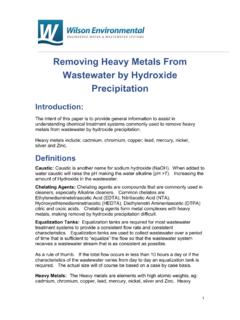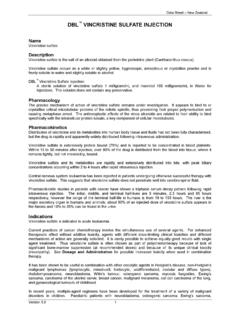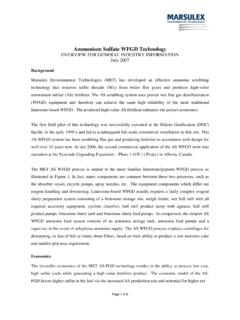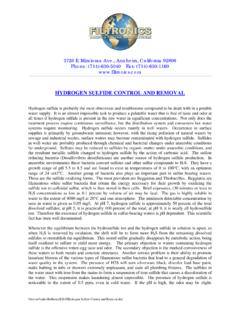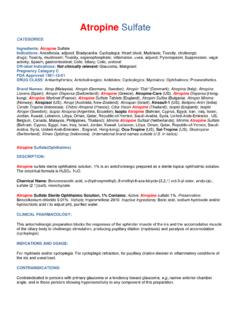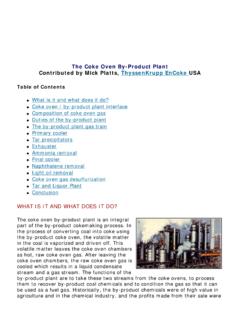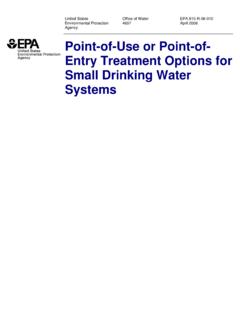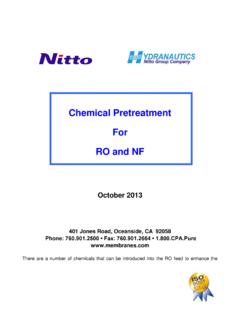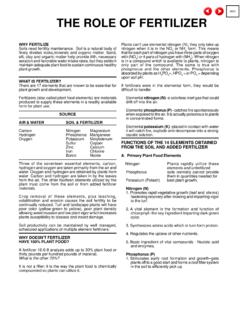Transcription of Removal of Molybdenum from Waste Water
1 Page 1 of 7 Removal of Molybdenum From Industrial Waste Water The intent of this paper is to provide general information to assist in understanding treatment technologies for removing Molybdenum from Waste Water . What is Molybdenum Molybdenum is a chemical element with symbol Mo Molybdenum is classified as a trace metal because it does not occur naturally as a free metal on Earth; it is found only in various oxidation states in minerals. Most Molybdenum compounds have low solubility in Water , but when Molybdenum -bearing minerals contact oxygen and Water , the resulting molybdate ion MoO2 is soluble. Industrially, Molybdenum compounds are used in high-pressure and high-temperature applications as pigments and catalysts.
2 About 86% of Molybdenum produced is used in metallurgy, with the rest used in chemical applications. The estimated global use is structural steel 35%, stainless steel 25%, chemicals 14%, tool & high-speed steels 9%, cast iron 6%, Molybdenum elemental metal 6%, and superalloys 5%. (From Wikipedia) Why is Molybdenum a Concern If a sewage plant receives excess Molybdenum in the influent Waste Water , it will end up in what is called bio-solids. Bio-solids are the non-digestible solids generated in the typical biological treatment of domestic sewage . Bio-solids from most city sewage treatment plants are put to a beneficial reuse. This is often fertilizer or compost. For example in Florida, bio-solids are applied to the soil in orange groves.
3 Human toxicity data for Molybdenum is currently unavailable. However, animal studies have shown Molybdenum to be toxic and that chronic ingestion can damage the lungs, kidneys, and liver. Low soil concentration of Molybdenum in a geographical band from northern China to Iran is associated with increased rates of esophageal cancer. Compared to the United States, people living in areas with elevated Molybdenum have about 16 times greater risk for esophageal cancer. Molybdenum dusts and fumes, generated by mining or metalworking, can also be Page 2 of 7 toxic, especially if ingested (including dust trapped in the sinuses and later swallowed). Low levels of prolonged exposure can cause irritation to the eyes and skin.
4 Direct inhalation or ingestion of Molybdenum and its oxides should be avoided. (Wikipedia) Molybdenum Regulatory Issues In recent years many Cities have added Molybdenum limits to industrial discharge permits or have decreased the limit in their industrial permits. We have seen limits ranging from mg/l to 10 mg/l in local sewer permits. See 40 CFR 503 Subpart B Land application of Bio-solids Limit for Molybdenum 75 mg/kg, for additional information. Potential Sources of Molybdenum in Waste Water Truck and Car Washes Oil Field equipment Washing Deicing Products Antifreeze Hospital Sterilization Units Water Treatment o Boilers o Cooling Towers o Closed Loop Heating and Cooling Units Removing Molybdenum from Waste Water Molybdenum is one of the more difficult chemical elements to remove from Waste Water .
5 Bench scale testing should be conducted prior to constructing a full scale treatment system. Bench Scale Testing for Removing Molybdenum When designing a Molybdenum Removal system for industrial wastewater, bench scale testing is required to properly engineer the system. Page 3 of 7 Bench Scale - Bench scale testing is needed in industrial applications to first; determine if the wastewater stream is even treatable by the selected process and to determine how long it takes to achieve the desired results. From the bench scale testing results, an estimate of the feasibility of using the selected process can determined. A budgetary estimate can be made at this point before going to pilot study or to the design and build phase of the project.
6 Pilot Testing- Pilot testing is recommended if favorable results are obtained from the bench scale testing. A pilot test is generally the next step. Pilot testing can be described as on site testing at the actual location under actual conditions. This is accomplished by taking a real time side stream of the wastewater and testing the process that is being considered before going to full-scale construction. Bench scale testing is always advised for treating Waste Water , especially for removing difficult chemicals such as Molybdenum . Note: Soaps, degreasers and chelating agents (EDTA) contained in many cleaners will negatively impact the Removal process. Recommended Bench Scale Tests for Molybdenum Removal .
7 Test 1. Determine the amount of soluble and insoluble Molybdenum by filtering. Use a 10 micron filter for this test. Simple filtering may do the job. Test 2. Remove the high concentration by adsorption using a sodium bentonite clay to bring down an initial high concentration. Add sodium bentonite to a continuously stirred container until clarity is achieved. This is known as jar testing. Note: chelated Molybdenum is resistant to adsorption. Test 3. Convert the soluble Molybdenum to insoluble Ferric Molybdate and separate. This can be accomplished by the addition of Ferric Sulfate to a pH of <4 and precipitate with lime addition to a pH of to 8. The insoluble Ferric Molybdate will settle with the addition of a polymer.
8 The settled Ferric Molybdate should be non-toxic and can be disposed of in most sanitary landfills. The Water above the settled material should be clear and should be acceptable to most sanitary sewer systems. Engineering Design and Process Equipment Molybdenum Removal can be accomplished in both continuous and sequential batch processes. A typical batch operation would consist of chemical storage and dosing modules ( FeSO4 and lime/NaOH); a primary reactor and pretreatment holding tank; a solids dewatering device (box or filter press); and miscellaneous temperature and pH controls. The materials of construction for the reactor and holding tank are typically, Types 304 or 316 stainless steel, while those for the chemical storage systems may also Page 4 of 7 be HDPE.
9 Wilson Environmental can provide you with engineering guidance on custom designs and retrofits. Water Reuse When reuse of the treated Water is desired, the treated Water must be disinfected before use for worker health and safety. There are numerous ways to achieve this. Chlorine disinfection is common. Ozone can also be used for disinfection as well as UV light. Disinfection should be addressed on a case by case basis. Equalization Tanks Equalization Tanks are required for most wastewater treatment systems to provide a consistent flow rate and consistent characteristics. Equalization tanks are used to collect wastewater over a period of time that is sufficient to equalize the flow so that the wastewater system receives a wastewater stream that is as consistent as possible.
10 As a rule of thumb. If the total flow occurs in less than 10 hours a day or if the characteristics of the wastewater varies from day to day an equalization tank is required. The actual size will of course be based on a case by case basis. Conclusions For Industrial wastewater treatment, off-the-shelf designs seldom work as desired. Bench scale testing and pilot testing are generally required for the proper design of a treatment system in an industrial setting. Beware of vendor claims based on gallons per minute when purchasing a unit for industrial applications. The level of operational expertise in industrial applications is often beyond what is available in terms of both man power and operational expense including monitoring for compliance.
